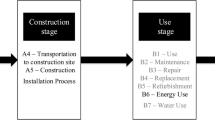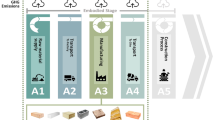Abstract
Reducing energy consumption in the construction sector is important in terms of limiting carbon emissions, saving fossil fuel and reducing the cost of materials. Solving the problem of affordable housing and improving the energy efficiency of the existing stock is urgent in Ukraine. It is achieved in particular by reconstruction with the addition of new floors. This work is devoted to developing an energy-efficient solution for the external wall and evaluating its environmental impact. Several types of wall solutions were analyzed and compared using traditional wall materials, such as ceramic bricks (solid and hollow), porous ceramics, autoclaved aerated concrete and foam concrete in terms of embodied energy and CO2 emissions. The comparison showed that the embodied energy of traditional wall structures is 2.8 times higher than that of energy-efficient building materials, which is caused by high density of ceramic brick and significant energy consumption for its burning. CO2 emissions from ceramic bricks and environmentally friendly aerated concrete are 191 kg CO2/m2 and 70 kg CO2/m2, respectively.
Access this chapter
Tax calculation will be finalised at checkout
Purchases are for personal use only
Similar content being viewed by others
References
Attia, S., Kosiński, P., Wójcik, R., Węglarz, A., Koc, D., Laurent, O.: Energy efficiency in the polish residential building stock: a literature review. J. Build. Eng. 45, 103461 (2022)
Appolloni, L., D’Alessandro, D.: Housing spaces in nine European countries: a comparison of dimensional requirements. Int. J. Environ. Res. Public Health 18(8), 4278 (2021)
Kapalo, P., Sedláková, A., Košičanová, D., Voznyak, O., Lojkovics, J., Siroczki, P.: Effect of ventilation on indoor environmental quality in buildings. In: 9th International Conference on Environmental Engineering, (2014)
Yüksek, I.: The evaluation of building materials in terms of energy efficiency. Periodica Polytech. Civ. Eng. 59, 48–58 (2015)
Rezaei, F., Bulle, C., Lesage, P.: Integrating building information modeling and life cycle assessment in the early and detailed building design stages. Build. Environ. 153, 158–167 (2019)
Castro-Lacouture, D., Sefair, J.A., Flórez, L., Medaglia, A.L.: Optimization model for the selection of materials using a LEED-based green building rating system in Colombia. Build. Environ. 44(6), 1162–1170 (2009)
Gutowski, T., Sahni, S., Allwood, J., Ashby, M., Worrell, E.: The energy required to produce materials: constraints on energy-intensity improvements, parameters of demand. Phil. Trans. R. Soc. A 371, 20120003 (2012)
Mahboob, M., Ali, M., Rashid, T., Hassan, R.: Assessment of embodied energy and environmental impact of sustainable building materials and technologies for residential sector. Eng. Proceed. 12, 62 (2021)
Usta, P., Zengin, B.: The energy impact of building materials in residential buildings in Turkey. Materials 14(11), 2793 (2021)
Venhryn, I., Shapoval, S., Voznyak, O., Datsko, O., Gulai, B.: Modelling of optical characteristics of the thermal photovoltaic hybrid solar collector. Int. Sci. Tech. Conf. Comput. Sci. Inf. Technol. 1, 255–258 (2021)
Bozdağ, Ö., Seçer, M.: Energy consumption of RC buildings during their life cycle. Portugal SB07. Sustainable Construction, Materials and Practices, pp. 480–487 (2007)
Dixit, M.K., Fernández-Solís, J., Lavy, S., Culp, C.H.: Identification of parameters for embodied energy measurement: a literature review. Energy Build. 42(8), 1238–1247 (2010)
Pozniak, O., Melnyk, V., Margal, I., Novosad, P.: Production of fly ash aerated concrete and efficiency of its application. In: Blikharskyy, Z. (ed.) EcoComfort 2020. LNCE, vol. 100, pp. 347–352. Springer, Cham (2021). https://doi.org/10.1007/978-3-030-57340-9_42
Novosad, P.V., Pozniak, O.R., Melnyk, V.M., Braichenko, S.P.: Porous thermal insulation materials on organic and mineral fillers. In: Blikharskyy, Z., Koszelnik, P., Mesaros, P. (eds.) CEE 2019. Lecture Notes in Civil Engineering, vol. 47, pp. 354–360. Springer, Cham (2020). https://doi.org/10.1007/978-3-030-27011-7_45
Serdyuk, V., Rudchenko, D., Dyuzhilova, N.: The use of low clinker binders in the production of autoclaved aerated concrete by cutting technology. Eastern-Eur. J. Enterp. Technol. 6(1–108), 63–71 (2020)
Sanytsky, M., Kropyvnytska, T., Fic, S., Ivashchyshyn, H.: Sustainable low-carbon binders and concretes. In: E3S Web of Conferences, vol. 166, p. 06007 (2020)
Szewczenko, W., Kotsay, G.: Alkaline activity of Portland cement with additives of waste glass. Materials 14(6), 1346 (2021)
Aruova, L., Dauzhanov, N., Tokmyrza, B., Utkelbaeva, A., Shashpan, Z.: Innovative technologies for producing foam concrete products using solar energy. Int. J. Eng. Technol. (UAE) 7(4), 36–41 (2018)
Sanytsky, M., Marushchak, U., Olevych, Y., Novytskyi, Y.: Nano-modified ultra-rapid hardening Portland cement compositions for high strength concretes. In: Blikharskyy, Z., Koszelnik, P., Mesaros, P. (eds.) CEE 2019. Lecture Notes in Civil Engineering, vol. 47, pp. 392–399. Springer, Cham (2020). https://doi.org/10.1007/978-3-030-27011-7_50
Marushchak, U., Sydor, N., Braichenko, S., Margal, I., Soltysik, R.: Modified fiber reinforced concrete for industrial floors. IOP Conf. Ser. Mater. Sci. Eng. 708(1), 012094 (2019)
Marushchak, U., Sanytsky, M., Sydor, N., Braichenko, S.: Research of nanomodified engineered cementitious composites. In: Proceedings of the 2018 IEEE 8th International Conference on Nanomaterials: Applications and Properties, NAP 8914835 (2018)
Solodkyy, S., Novytskyi, Y., Topylko, N., Turba, Y.: Research of influence of polymer additives-stabilizers on physical-mechanical indicators and microstructure of cement ground. IOP Conf. Ser. Mat. Sci. Eng. 708(1), 012107 (2019)
Hammond, G., Jones, C.: Embodied carbon: the inventory of carbon and energy (ICE). BSRIA: Bracknell, UK (2011)
Zimele, Z., Sinka, M., Korjakins, A., Bajare, D., Šahmenko, G.: Life cycle assessment of foam concrete production in Latvia. Environ. Clim. Technol. 23, 70–84 (2019)
Author information
Authors and Affiliations
Corresponding author
Editor information
Editors and Affiliations
Rights and permissions
Copyright information
© 2023 The Author(s), under exclusive license to Springer Nature Switzerland AG
About this paper
Cite this paper
Marushchak, U., Pozniak, O., Mazurak, O. (2023). Assessment of Wall Structures for Reconstruction of Buildings. In: Blikharskyy, Z. (eds) Proceedings of EcoComfort 2022. EcoComfort 2022. Lecture Notes in Civil Engineering, vol 290. Springer, Cham. https://doi.org/10.1007/978-3-031-14141-6_27
Download citation
DOI: https://doi.org/10.1007/978-3-031-14141-6_27
Published:
Publisher Name: Springer, Cham
Print ISBN: 978-3-031-14140-9
Online ISBN: 978-3-031-14141-6
eBook Packages: EngineeringEngineering (R0)




